Historic St. Mary's Mission
Introduction
Text-to-speech Audio
Images
St. Mary's Second Historic Chapel, 1934
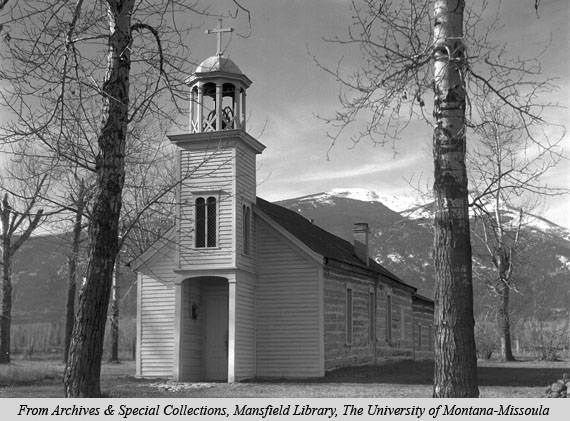
A group of Native Americans sitting in front of the original mission circa 1880s
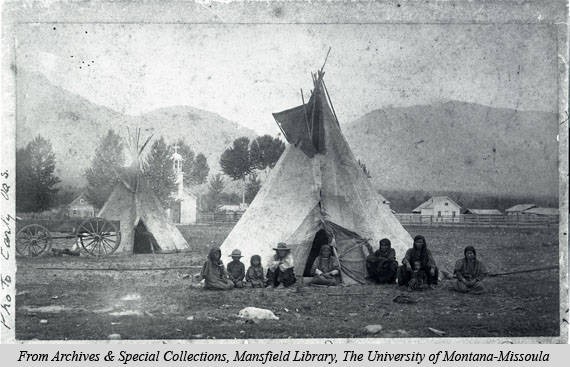
A current photo of St. Mary's Mission Chapel, October 2019
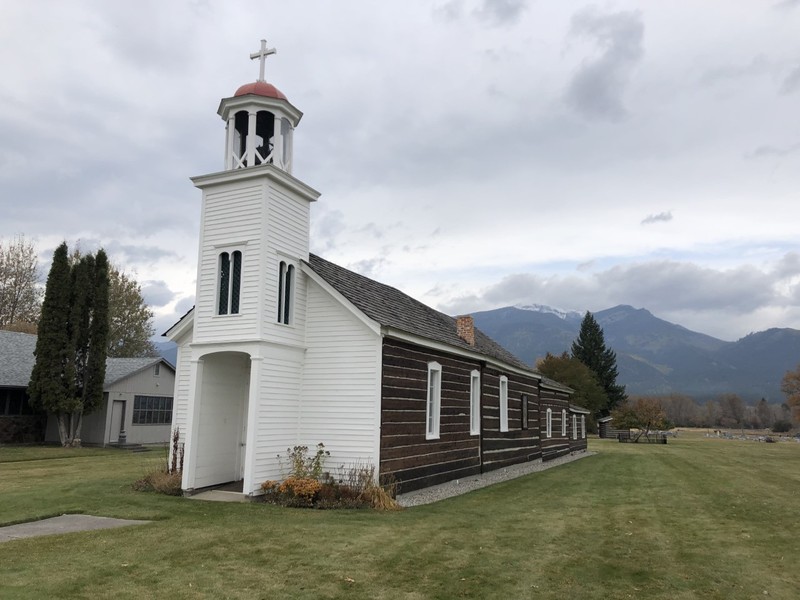
A view of the Bitterroot Mountains from the Mission grounds, October 2019
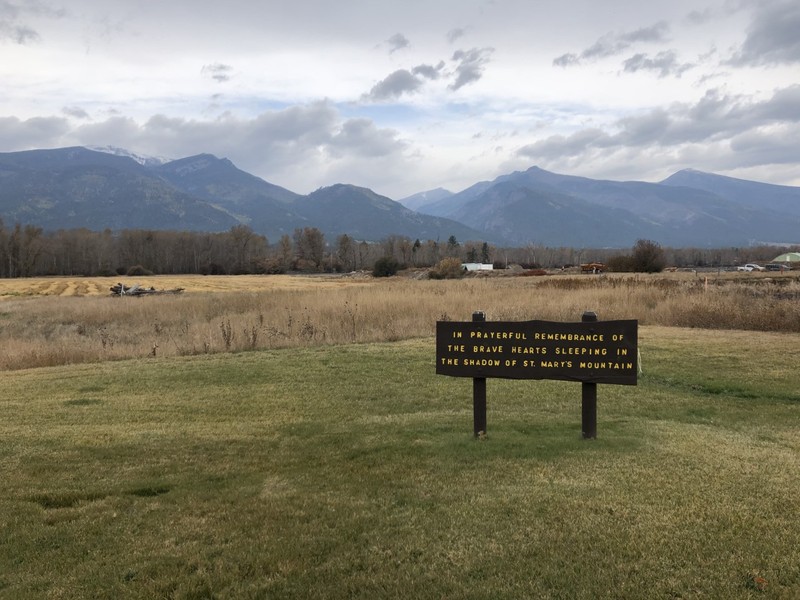
The historic pharmacy used by Father Ravalli to administer medications to residents in the area, July 1965
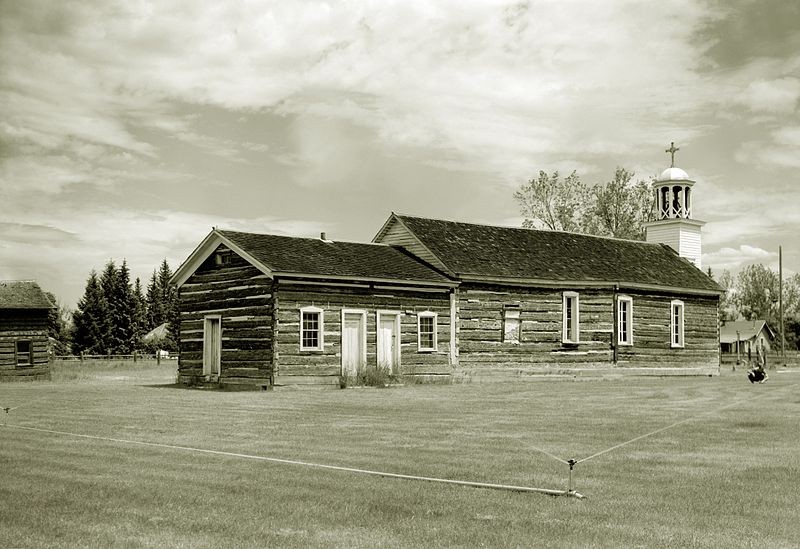
Backstory and Context
Text-to-speech Audio
Starting in the 1840s, the Catholic Church began sending priests westward on mission trips to spread the word of Catholicism to settlers and Native Americans in the region. One of the most prominent of these missionaries was Father Pierre Jean DeSmet. “Pierre Jean DeSmet had long been associated with the vast Missouri-Platte, upper Great-Basin and Columbia-snake geographic complexes. Between 1840-1870 one might find him in almost any Indian village, baptizing or blessing children, instructing adults, or simply talking” (Antrei, p. 26). In 1840, DeSmet embarked on a westward trip from St. Louis, leading a group of Catholic missionaries. The most notable of the missionaries included Father Nicolas Point, a French priest and painter, and Father Gregory Mengarini, an Italian priest and linguist. During his time in Western Montana, Father DeSmet came to know and respect the Salish Indians, who were the predominant group that resided in the Bitterroot Valley. He proselytized the Catholic faith to them, and they were receptive to his teachings, because the Salish people believed power derived from spiritual belief. Historian Gerald McKevitt, explained, “the native peoples, who, like the Jesuits, believed that the supernatural world could be communicated with, valued and affirmed the power of prayer….One of the reasons why they invited the Black Robes to come among them was to learn their invocations and thereby acquire Christian power” (p. 55).
The Salish expressed their commitment to the Catholic faith, so Father DeSmet created the St. Mary’s Mission on September 24, 1841. Father DeSmet, Father Mengarini, and Father Point successfully planned and built the first structures of the mission. Point wrote in his journal,“when the hunters returned from their summer hunt, the cross was already elevated above the site of their future reduction, and their chapel was also rising. At the sight of the work going on, which had for the Indians all the interest of a novelty, and which promised so much for their future, there was a universal joy in the camp” (p. 41). The priests also introduced agricultural practices into the Salish’s traditional hunting and gathering survival techniques. In 1845, Father Ravalli joined his fellow Jesuit missionaries in the area and provided basic medical care to the Salish. In 1846, the Salish discovered that Father DeSmet had been sharing Catholicism with their enemies, the Blackfeet Indians. Father DeSmet attempted to bridge the divide between the two tribes; however, the attempt was ultimately unsuccessful. The Catholic Church consequently closed the mission in 1850 and sold the land to John Owen, an Army veteran. The Church burned the original mission structures down in order to “save it from desecration” (St. Mary’s Mission Website). Owen used the land where the mission previously stood to build Fort Owen and established it as a trading post in the valley.
In 1866, the Catholic Church decided to rebuild the Catholic community in the Bitterroot Valley and sent Father Ravalli to re-establish St. Mary’s Mission. He rebuilt the mission one mile from its original location, and expertly reinvigorated the Salish community’s practice of Catholicism. Ravalli continued to provide medical care as well as administer medication among the Salish and the community at large. However, in 1891, the federal government forcibly removed the Salish from their ancestral homeland and marched them onto the Flathead Reservation north of Missoula. This event ceased Native practice of Catholicism and caused the mission to close its doors once again. The Catholic Church re-opened St. Mary’s in 1921 and the congregation used the historic chapel until 1951. The congregation then built a new chapel, which is still in use today.
Currently, the mission’s campus includes the historic chapel, Father Ravalli’s original living quarters, Chief Victor’s cabin (which serves as a Salish museum), a reproduction of a Salish teepee camp, and the congregation's graveyard, where Father Ravalli is buried. As a visitor, you can participate in a tour of the mission from April to mid October and see the historic grounds.
Cite This Entry
Jabour, Anya and Halle Townes . "Historic St. Mary's Mission." Clio: Your Guide to History. December 10, 2019. Accessed March 18, 2025. https://theclio.com/entry/88613
Sources
Antrei, Albert. "Father Pierre Jean DeSmet." Montana: The Magazine of Western History, vol. 13, no. 2. (Spring 1963), 24-43.
Bigart, Robert. Getting Good Crops: Economic and Diplomatic Survival Strategies of the Montana Bitterroot Salish Indians 1870-1891. Norman, Oklahoma: Oklahoma University Press, 2010.
Form, MT_RavalliCo_UniversityHeightsHD, Darby (Mont.) National Register of Historic Places registration form, 8/14/2012, Montana State Historic Preservation Office, Montana on the National Register of Historic Places, Montana Memory Project https://mtmemory.org/digital/collection/p103401coll12/id/5399/rec/20
Historic St. Mary’s Mission and Museum est. 1841. Accessed October 1st 2019. https://www.saintmarysmission.org/.
McKevitt , Gerald. "The Art of Conversion: Jesuits and Flatheads in Nineteenth-Century Montana." U.S. Catholic Historian, vol. 12, no. 4 (Fall 1994), 49-64.
Peterson, Jacqueline. Sacred Encounters: Father DeSmet and the Indians of the Rocky Mountain West. Norman, Oklahoma: University of Oklahoma Press, 1993.
Point, Nicolas. Donnelly , Joseph P. , editor. Wilderness Kingdom, Indian Life in the Rocky Mountains: 1840-1847; the Journals & Paintings of Nicolas Point. Edition 1st. New York , New York. Holt, Rinehart and Winston, 1967.
Rolle, Andrew F. "The Italian Moves Westward." Montana: The Magazine of Western History, vol. 16, no. 1. (Winter 1966),13-24.
Photo, “St Mary’s Mission”, Saint Mary’s Mission in Stevensville, Montana, January 28, 1934, Archives and Special Collections, University of Montana-Missoula, Mansfield Library, Archival Photographs from the University of Montana, Montana Memory Project, https://mtmemory.org/digital/collection/p16013coll27/id/18/rec/1
Photo, “St. Mary’s Mission Church, Stevensville”, A group of Indians sitting in front of tipis pitched in front of St. Mary’s Mission Church in Stevensville, Montana sometime in the early 1880’s. St Mary’s Peak in the background, circa 1880’s, Archives and Special Collections, University of Montana- Missoula, Mansfield Library, Archival Photographs from the University of Montana, Montana Memory Project, https://mtmemory.org/digital/collection/p16013coll27/id/493/rec/2
Townes, Halle. "St Mary's Mission Chapel 2019". Digital Image, 2019.
Townes, Halle. " View of the Bitterroot Mountains From the Mission Grounds 2019". Digital Image, 2019.
Huntsman, Al. Library of Congress, Prints and Photograph Division HABS: MONT,41-STEV,1-5. https://en.wikipedia.org/wiki/St._Mary%27s_Mission_(Montana)#/media/File:St._Mary's_Church_and_Pharmacy-Retouch2.jpg. Accessed December 5, 2019.

